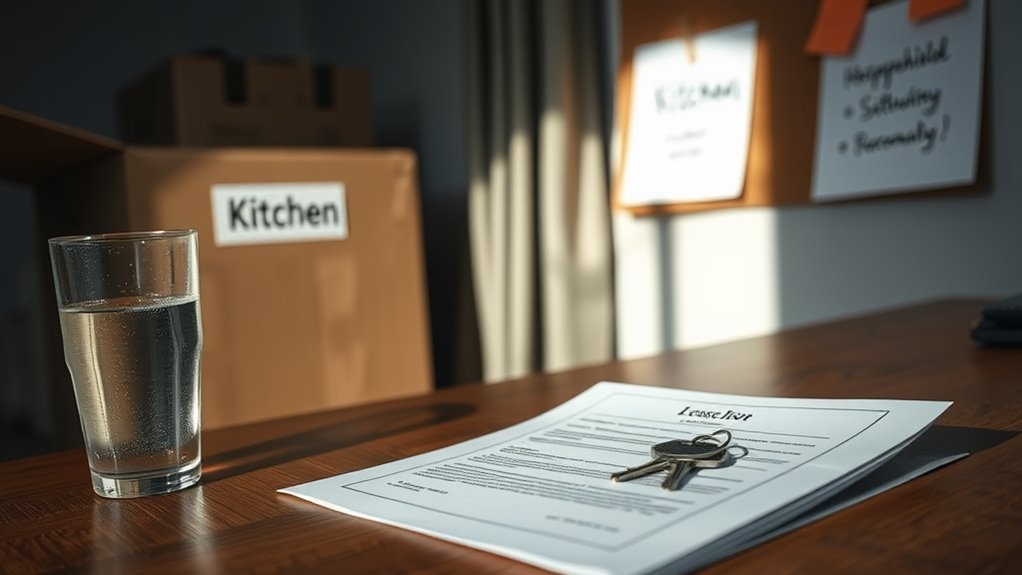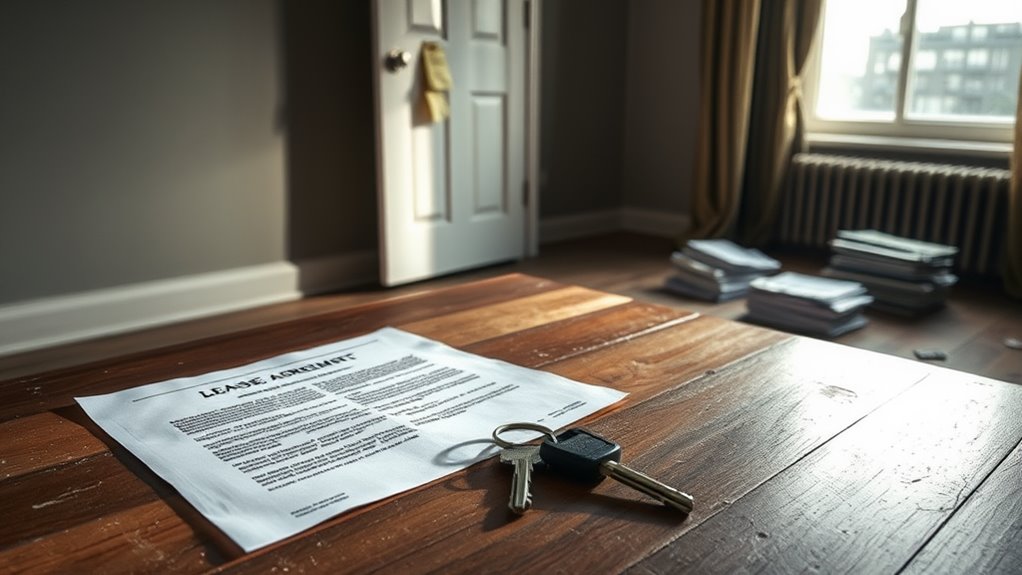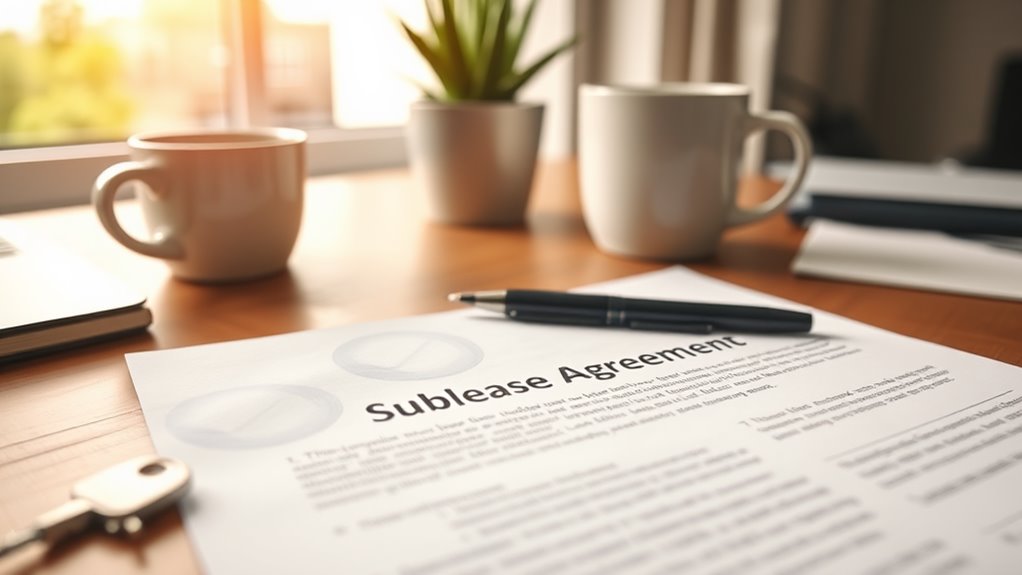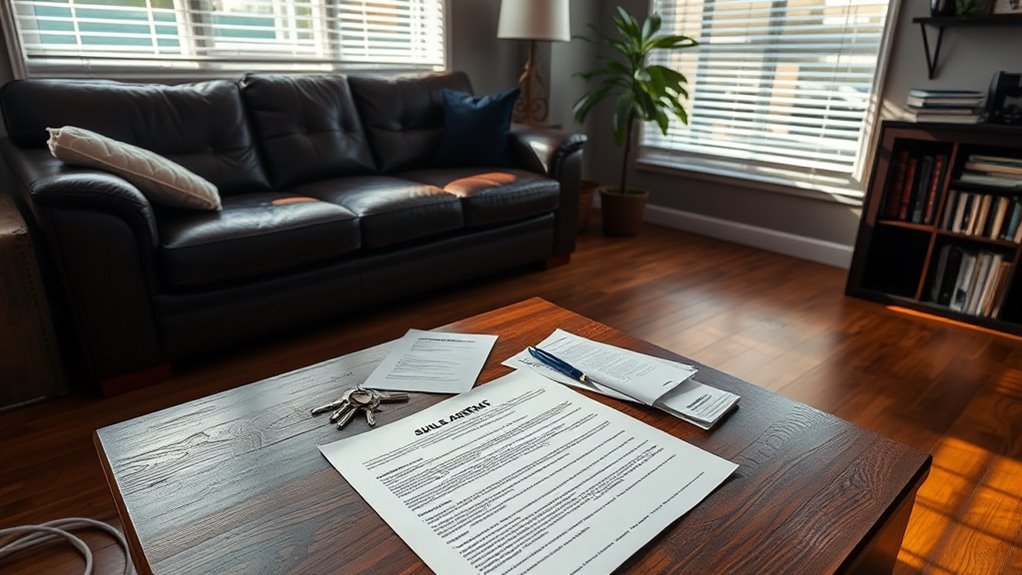A sublease is a legal agreement where you, as the original tenant, rent out the property to a subtenant while retaining your obligations under the primary lease. The subtenant occupies the property and pays rent to you, but you remain liable for all lease terms. Landlord consent is usually required, and the sublease must comply with the original lease. Understanding these details will help you navigate the process effectively.
Key Takeaways
- A sublease allows the original tenant to rent the property to a subtenant while remaining responsible for the original lease terms.
- The subtenant pays rent to the original tenant, who continues to pay the landlord.
- Subleasing typically requires the landlord’s consent to comply with the original lease agreement.
- The original tenant retains liability for rent and property damage caused by the subtenant.
- Subleases are often used for temporary relocations or financial adjustments without breaking the primary lease.
Definition of a Sublease
A sublease is a legal agreement in which the original tenant rents part or all of their leased property to a subtenant. In this arrangement, the original tenant maintains their obligations under the primary lease agreement with the landlord, while the subtenant assumes the right to occupy the rental property for a specified period. The subtenant pays rent to the original tenant, who remains responsible for making sure rent is paid to the landlord. Subleasing typically occurs when the original tenant temporarily vacates the premises due to reasons such as relocation or extended travel. The original tenant retains full liability for the lease terms, including property maintenance and any damages caused by the subtenant. Subleasing doesn’t transfer tenant rights or responsibilities to the subtenant unless explicitly outlined in writing. Both the original tenant and subtenant must make certain compliance with the lease agreement and landlord’s consent, if required.
Key Differences Between Sublease and Subletting

While both sublease and subletting involve a third party occupying a rental property, they differ substantially in structure and legal implications. In a sublease, the original tenant rents the property to a sub-tenant, retaining financial liability for rent and damages. Conversely, subletting involves a new tenant contracting directly with the landlord, relieving the original tenant of responsibility. Subleasing agreements are between the original tenant and sub-tenant, while subletting agreements are between the landlord and the new tenant. Landlords typically must consent to subleasing, whereas subletting may bypass the original tenant entirely. Sublease terms must comply with the original lease, whereas subletting terms are negotiated directly with the landlord.
| Aspect | Sublease | Subletting |
|---|---|---|
| Responsibility | Original tenant remains liable | Original tenant no longer liable |
| Agreement | Between original tenant and sub-tenant | Between landlord and new tenant |
| Landlord Consent | Usually required | May not involve original tenant |
| Terms | Must comply with original lease | Negotiated directly with landlord |
| Property Use | Sub-tenant occupies property | New tenant occupies property |
When Subleasing Might Be Necessary

If you need to relocate temporarily but plan to return to your rental property, subleasing might be necessary. Subleasing allows you to transfer partial possession of the property to a subtenant while retaining your obligations under the original lease. Here are scenarios where subleasing becomes essential:
- Relocation for Work or Study: You must leave temporarily for a job assignment or academic program but intend to return before the lease ends.
- Financial Hardship: You face financial difficulties and cannot afford the full rent, so subleasing helps cover unpaid rent without breaking the lease terms.
- Early Lease Termination Avoidance: You need to move before the lease expires but wish to avoid penalties for terminating the lease early.
- Roommate’s Departure: A roommate moves out, and you cannot pay the rent alone, making subleasing a practical solution.
Always verify your landlord approves subleasing to avoid violating lease terms.
Legal Considerations for Subleasing

Before subleasing, you must review your lease agreement to determine if landlord consent is required. You should also verify state-specific subleasing laws, as they may override lease clauses in certain jurisdictions. Guarantee your sublease complies with all applicable terms to avoid legal disputes.
Landlord Consent Requirements
When subleasing a rental property, you must obtain the landlord’s written consent, even if the original lease allows subleasing. Written permission is essential to confirm the sublease agreement complies with the terms of the original lease and applicable laws. The landlord may impose certain conditions, such as screening the subtenant or charging a processing fee. In some jurisdictions, the landlord must grant consent if specific legal requirements are met.
- The original lease may outline procedures for seeking landlord consent.
- Subleasing is allowed only if the landlord provides written permission.
- The landlord must review the subtenant’s qualifications, such as creditworthiness.
- Certain conditions, like additional fees, may apply during the approval process.
Failure to secure consent can invalidate the sublease agreement, leading to legal disputes between the landlord and tenant.
Lease Agreement Clauses
While subleasing a property, it’s crucial to examine the lease agreement for clauses addressing sublease permissions and conditions. The lease agreement must explicitly state whether subleasing is permitted, prohibited, or requires landlord approval. Some jurisdictions override clauses that entirely prohibit subleasing, granting tenants limited rights. If subleasing is allowed, landlords often impose specific conditions, such as written consent or adherence to tenant screening standards. Confirm the sublease clause aligns with state and local laws, which may supersede lease terms in certain cases. A well-drafted clause should outline responsibilities, including rent payment terms and procedures for addressing legal liability. Violating these terms can result in penalties or termination of the lease. Carefully reviewing these provisions protects your interests and guarantees compliance with both contractual and legal obligations. Annual leases provide stability and predictability, making them less likely to require subleasing arrangements due to tenant turnover.
State-Specific Subleasing Laws
Understanding state-specific subleasing laws guarantees compliance with varying legal frameworks across jurisdictions. Tenants Rights dictate permissible actions, but lease terms often control. When a tenant decides to sublease, landlord approval may be required unless waived in the original lease. The landlord may choose to reject a subtenant, but unreasonable denial could violate state laws, especially in California or Wisconsin. You’ll find that without proper adherence, lease termination could result. States like Texas offer streamlined eviction processes, which can impact subleasing agreements.
- New York: Tenants in buildings with four or more units need landlord consent.
- California: Landlords cannot unreasonably withhold sublease consent.
- Texas: Landlord approval is mandatory unless the lease waives it.
- Florida: Subleasing rules vary by county, but landlords retain approval rights.
Ensure a binding contract between you, the landlord, and the new subtenant to avoid disputes. Always review local laws before proceeding.
Responsibilities of the Original Tenant

You remain responsible for rent payments if the subtenant fails to fulfill their obligations. You must guarantee that the subtenant complies with all terms of the original lease agreement. Additionally, you’re liable for any property damages caused by the subtenant during the sublease period. It’s crucial to prevent unauthorized subletting by clearly outlining subleasing terms in your original lease to avoid liability risks and lease violations.
Rent Payment Obligations
Even if you sublease the property, you’re still legally obligated to pay the full rent to the landlord on time, regardless of whether the subtenant fulfills their payment obligations. As the original tenant responsible, you retain liability for rent payments even if the subtenant pays rent to you directly. If the subtenant fails to pay, you must cover the unpaid rent to avoid breaching the lease agreement. The original tenant retains the ultimate responsibility for paying rent to the landlord, guaranteeing compliance with the lease terms regardless of the subtenant’s actions. Utilizing a Long Term Rental Calculator can help you assess rental profitability and manage financial risks effectively.
- Original Tenant Responsibility – You remain liable for rent even if the subtenant defaults.
- Subtenant’s Payment – The subtenant pays rent to you, but this doesn’t absolve your obligation to the landlord.
- Direct Payment – Confirm rent is paid directly to the landlord as agreed.
- Monitor Payments – Track rent payments to prevent financial liability.
Property Damage Liability
Property damage liability remains a critical responsibility for the original tenant during a sublease. As the original tenant, you’re responsible for any property damage caused by the subtenant, even if they directly caused it. The landlord can hold you financially accountable for repairs under the lease agreement, and you may need to use your security deposit to cover costs if the subtenant refuses to pay. Unless your sublease is a binding agreement specifying the subtenant’s liability, you retain legal and financial responsibility for damages. To protect yourself, document the property’s condition before and after the sublease. This ensures clarity in disputes and helps enforce accountability. Always clarify damage responsibilities with the subtenant in writing to mitigate potential conflicts and protect your financial interests. Consider including inspection checklists to document the property’s condition thoroughly and avoid disputes.
Lease Term Responsibilities
The original tenant retains financial and legal obligations throughout the lease term, regardless of the subtenant’s involvement. As the original tenant, you’re responsible for guaranteeing compliance with the original lease agreement, even when a subtenant occupies the property. Your financial liability doesn’t transfer; you must secure rent payments to the landlord, irrespective of the subtenant’s actions. Failure to uphold these responsibilities can result in penalties, eviction, or legal action under the existing lease.
- Rent Payments: You must verify rent is paid on time, even if the subtenant defaults.
- Lease Compliance: The subtenant must follow all terms the lease says, and you’re accountable for enforcement.
- Property Damages: You’re liable for costs if the subtenant causes damage beyond normal wear and tear.
- Mediation: You must resolve disputes between the landlord and subtenant, maintaining adherence to the original lease agreement.
Risks for Landlords in Subleasing Arrangements

Subleasing introduces several risks for landlords, including potential financial and legal complications. When a landlord agrees to let a tenant sublease, the subtenant must still adhere to the original lease terms, but the landlord might lack direct control over their conduct. If the subtenant defaults on rent, the tenant still remains financially liable, but recovering payment can be time-consuming. Property damage risks increase if the landlord doesn’t conduct thorough background checks on subtenants or monitor the property. Disputes can also complicate the eviction process, as landlords may need to address multiple parties. Additionally, subleasing can violate the original lease with the landlord, requiring enforcement of contract clauses or legal action. Without a direct with the landlord relationship, subtenants may act irrespons, leading to unanticipated liabilities. Changes in interest rates can also impact the financial viability of subleasing arrangements, as they may affect borrowing costs for landlords managing rental properties. These risks underscore the importance of carefully evaluating subleasing arrangements to protect your interests.
How to Draft a Sublease Agreement

Creating a sublease agreement requires careful attention to detail to guarantee all parties understand their rights and obligations. You must verify the agreement includes clear terms and complies with the original written lease. Here are four essential steps to drafting a sublease agreement:
- Identify the Three Parties: Include the full names, addresses, and contact information of the original tenant, subtenant, and landlord.
- Define the Terms: Specify the duration of the sublease, including start and end dates, and outline renewal or termination clauses.
- Detail Rent Payments: Clearly state the rent amount, due dates, and payment methods, making certain of alignment with the original lease terms.
- Assign Responsibilities: Define repair, maintenance, and utility obligations, adhering to the original lease and local laws.
You must also obtain the landlord’s written consent and attach it to the sublease agreement to confirm its legal validity and avoid potential disputes over the property.
Tips for Finding a Reliable Subtenant

When seeking a reliable subtenant, you should first leverage trusted networks by asking friends, family, or colleagues for referrals, as this can enhance the likelihood of finding someone dependable. Once you’ve identified potential candidates, verify their financial stability by requesting proof of income to guarantee they’re capable of paying the rent consistently. Conduct thorough tenant background checks and credit checks to evaluate their reliability and past behavior as tenants. It’s also essential to assess whether the new tenant might renew their lease or continue subleasing the property to someone else. To further protect your interests, tenants need to understand the terms of the sublease and their responsibilities. Use the table below to guide your selection process:
| Step | Action | Purpose |
|---|---|---|
| Network Referrals | Ask friends/family for referrals | Identify trustworthy candidates |
| Verification | Request proof of income | Guarantee financial stability |
| Screening | Conduct background and credit checks | Assess reliability and past behavior |
Conclusion
When traversing the waters of subleasing, remember it’s akin to passing the baton in a relay race. You retain ultimate responsibility, even as another runs the leg. Guarantee your sublease agreement is airtight, like a well-crafted contract, safeguarding your interests while meeting legal standards. Choose your subtenant with care, as though selecting a trusted co-pilot. By balancing caution with clarity, you can steer clear of pitfalls and keep your rental journey on course.




